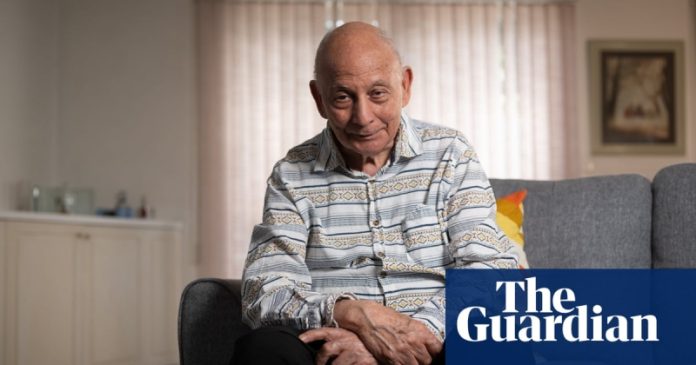Roofing flying through the air, windows shattering, the terror as houses disintegrated – these are the motifs woven through the stories of Tracy survivors
In 1974, months before Cyclone Tracy flattened Darwin, Bob Leicester was working with Greg Reardon as part of a CSIRO team called Keep Your Roof On.
“We were going around capital cities and big towns to give seminars on how we should change building practices,” Leicester says.
Some cities were happy to hear how they could make buildings more resilient to cyclones. But generally they were negative, he says. “Why do we have to change our buildings?” they would ask.
“Darwin was one of the places that year that we’d approached,” he says.
“A chief construction engineer told us we were wasting our time, that they had been building here for 30 years and didn’t need to be told.”
He pauses.
“His house got destroyed.”
On Christmas Eve, the citizens of Darwin were meant to be hunkering down. The Bureau of Meteorology had been warning since 21 December that Tracy was coming.
But there was a sense of complacency, as the former NT administrator John Hardy writes in the forward to Richard Creswick and Derek Pugh’s book Tracy: 50 Years, 50 Stories. In part, that was because three weeks earlier there had been warnings that Cyclone Selma would hit Darwin. But Selma petered out and headed back to sea.
When Tracy struck in the early hours of Christmas Day, 66 people died. Ten times that number were injured. Most houses were beyond repair.
Wind gusts reached 217km/h before debris destroyed the Bureau of Meteorology’s measuring equipment. There are estimates the speeds may have reached 300km/h.
A storm surge of four metres hit Casuarina beach and 255mm of rain fell in 12 hours. Tens of thousands of people were left homeless and the bill hit more than $800m (equivalent to more than $7.5tn in 2024).
The Bureau of Meteorology says the tropical cyclone “crawled through the city at less than 10km/h – allowing time for the fearsome gusts, flying roofing materials, tree branches and other debris to exert maximum damage”.
The complacency, the distractions of Christmas, the direct hit on the city, and the shoddy building created the “perfect storm”, the bureau says.
In one of the stories published in Tracy, Peter Harney writes that he was “swept up in the weird troppo craziness of Darwin”. He was partying with “crazy characters” at the Don hotel when someone suggested they get stoned and go to the beach to watch Tracy come in.
Instead, they huddled inside as roofs were torn off and windows exploded. They emerged in the morning to “massive devastation”.
Rodney Gregg was nine at the time and writes that when his father woke him up he and his twin brother, Ashley, grabbed some presents from under the tree and the family tried to flee in the car – but it wouldn’t start, a failure that may have saved them. They huddled there, “cold, scared and shivering”, and waited it out.
“The sound of a town in terror is something that we will never forget,” he writes. “The scraping of hundreds of iron roof sheets, the howling wind, the thunder and the rain.”
Roofing flying through the air, windows shattering, the horror as houses disintegrated – these are the motifs woven through the stories of Tracy survivors.
Canberra, meanwhile, was in a darkness of its own. Communications were down for five days, with only patchy information getting through.
Leicester heard about the cyclone almost by chance, thanks to a contractor who mentioned the devastation to his brother-in-law in Timor.
He flew in from Laverton air force base near Melbourne to survey the damage, arriving in tropical Darwin on a freezing cold Hercules – a military transport plane not designed for human comfort.
“They were evacuating the city,” Leicester says. “Most people were out by the time I got here.” He and a few others were dropped at the airport late at night and pointed towards town.
“The shops still standing were empty,” he says. “It reminded me of wartime in Singapore. There was just nothing there.
“I went to sleep in a shop somewhere.”
Leicester wanted Reardon to join the mission but he was on holiday in Taree, on the New South Wales mid-north coast. Before leaving Melbourne, Leicester asked his secretary to track Reardon down. She looked at a map, picked a corner store and asked the owners to stick a notice in the window saying, “Greg, go to Darwin.” And so Reardon arrived just a day after Leicester.
Leicester searched for and eventually found the CSIRO building, one of only a few places that survived intact. The whole town was blacked out but a buffalo hunter who was on staff brought in a fridge and a generator.
“They were still picking up the occasional body in the rubble,” Leicester says. “We looked at this one house, it had a terrible stink … we found a big sack of prawns.
“They went to all the houses they knew staff [who had evacuated] had lived in and got all their Christmas dinners out, so we had Christmas every evening while everyone else was sitting in darkness.”
They looked at about 2,700 houses and the myriad ways in which they had failed. No type of housing was built to withstand those winds, he says.
The work of the CSIRO group before and after Tracy transformed the nation’s building codes, improving safety standards.
Houses now have to be structurally engineered to withstand strong winds, and to recognise that internal pressure when windows and doors fail contributes to roof “uplift”. Screws are now used instead of nails to more firmly fasten roofs down.
Darwin was effectively rebuilt in three years, thanks to the Darwin Reconstruction Commission.
Better engineering, along with improved communication and emergency management, means Leicester is optimistic that sort of disaster will never happen again, despite the climate crisis increasing the intensity of tropical cyclones.
Tracy – and Cyclone Althea in 1971 – reinforced the need for a research centre and source of practical information, and a cyclone testing station was set up in Townsville. The station is now an independent centre within the engineering school at James Cook University.
Dr David Henderson is the station’s chief engineer. He describes Leicester and Reardon – and a broader group that transformed building standards, including George Walker, Hugh Trollope, Theo Wilkinson and Kevin Macks – as “heroes”.
The station provides advice for codes and standards to make houses safe, resilient and functional. It’s not just about stopping houses getting blown away, although that’s part of it, Henderson says. It’s also a matter of how soon they can become habitable again, how water infiltrates electrics and mould infiltrates buildings.
They use scale models, with tubes and pressure sensors, and a pressure chamber to test products for industry. They test components, applying difference forces to find weaknesses.
Henderson has been at the station since 1991 but says he told Reardon he still feels like a “fraud” sometimes.
“[Reardon] said: ‘We all stand on the shoulders of giants.’
“To me, Greg is a giant. They all are.
“They’ve all done so much to make our houses safer, our community safer. To me they are heroes.”

